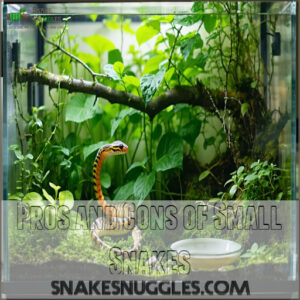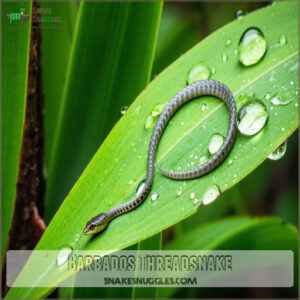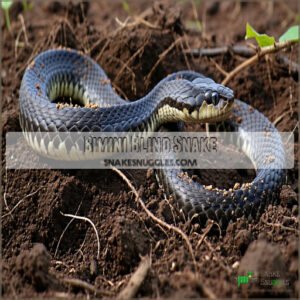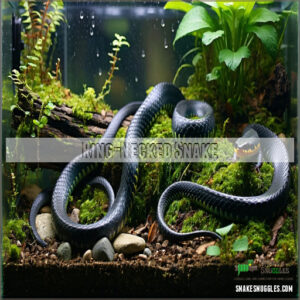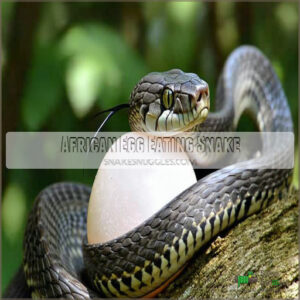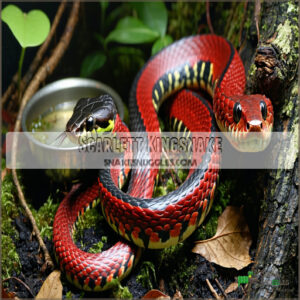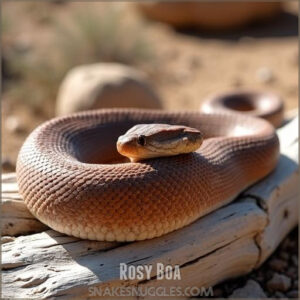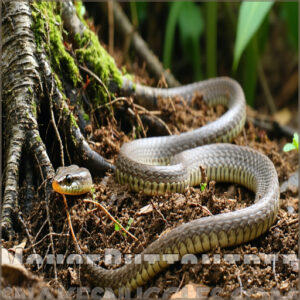This site is supported by our readers. We may earn a commission, at no cost to you, if you purchase through links.
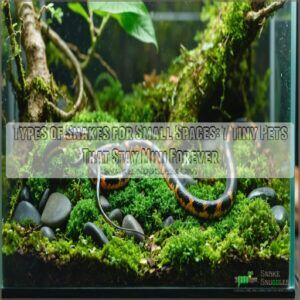 If you’re tight on space but dreaming of a scaly friend, you’ve got great options for types of snakes that stay compact.
If you’re tight on space but dreaming of a scaly friend, you’ve got great options for types of snakes that stay compact.
Ring-necked snakes thrive in 10-gallon terrariums, while Western Hognose snakes rarely exceed 24 inches for males. African egg-eating snakes and Kenyan Sand Boas make perfect apartment dwellers, staying under 32 inches.
These smaller species aren’t just space-savers – they’re easier to handle and cost less to house. Plus, they’ve got personality to spare: Western Hognoses are known for their dramatic hissing displays, while Ring-necks charm with their gentle nature.
Each species brings its own special care requirements and fascinating behaviors.
Table Of Contents
- Key Takeaways
- Pros and Cons of Small Snakes
- Smallest Snake Species in The World
- Best Small Snakes for Pet Owners
- MouseButtontree
- Frequently Asked Questions (FAQs)
- What kind of snake stays small?
- What is the most low maintenance snake?
- Can snakes live in small spaces?
- What small snake is a good pet?
- What are the best small pet snakes?
- What are the different types of small pet snakes?
- What is the smallest snake you can keep as a pet?
- What are the best small snakes for beginners?
- What are the best low maintenance snakes?
- Are there any pet snakes that stay small?
- Conclusion
Key Takeaways
- You’ll find several species that thrive in compact spaces, including Ring-necked snakes (10-gallon tank), Western Hognose (24 inches max), African egg-eating snakes and Kenyan Sand Boas (under 32 inches).
- You won’t need to spend as much on small snakes since they require less space, food, and simpler setups than larger species, though they do need more attention to temperature and humidity control.
- You can expect distinct personalities from these compact companions – Western Hognoses charm with dramatic displays while Ring-necked snakes offer gentle temperaments, making them engaging pets despite their size.
- You’ll need to monitor your small snake more carefully as they’re more sensitive to environmental changes and handling stress than larger snakes, requiring precise habitat maintenance for optimal health.
Pros and Cons of Small Snakes
You’ll find that small snakes need less space and food than their larger cousins, saving you money while still giving you all the joy of reptile ownership.
They can be more sensitive to handling and temperature changes though, so you’ll need to pay extra attention to their specific care needs.
Advantages of Keeping Small Snakes
The joy of small snake ownership comes with practical perks.
You’ll love how these apartment-friendly pets save space, fitting perfectly in compact setups.
Small snake breeds like ring-necked snakes cost less to feed and house, making your wallet happy.
Their manageable size means easier handling, especially if you’re new to reptile care.
You’ll appreciate their simple setup requirements and less demanding nature.
Whether you’re in a tiny apartment or just prefer smaller pets, these mini serpents offer big advantages in small packages.
Challenges of Caring for Small Snakes
Five important challenges come with caring for small snakes.
These tiny pets are more sensitive to handling stress and environmental changes than their larger cousins.
You’ll need precise humidity control in their small snake enclosures, plus specialized diets that often include specific prey items.
Tank cleaning requires extra attention since waste quickly affects limited spaces.
Temperature sensitivity is also vital – tiny fluctuations can cause big problems in compact setups.
Understanding proper snake care basics is essential for creating a suitable environment for these small pets, and you can learn more about it through resources like the snake care basics guide, which helps with handling stress, environmental changes, and maintaining the right temperature sensitivity for your pet.
Smallest Snake Species in The World
You’ll be amazed that the world’s smallest snakes, like the 4-inch Barbados Threadsnake, can fit in your palm yet make fascinating pets.
You can easily keep these tiny wonders in compact terrariums, making them perfect for apartment living or small spaces, which is a key aspect of their appeal as fascinating pets.
Barbados Threadsnake
While small snakes can fit into compact spaces, the Barbados threadsnake takes tiny to a whole new level.
As the world’s smallest snake species, these miniature marvels measure just 4 inches long – about as thin as a spaghetti noodle! These snakes are considered an endangered threadsnake species.
Here’s what makes these tiny snakes so fascinating:
- Native to Caribbean islands like Barbados and Antigua
- Feed exclusively on ant and termite larvae
- Too small for traditional Snake Diet requirements
- Need specialized Small Enclosures if kept
- Require expert Threadsnake Care knowledge
Bimini Blind Snake
While the Barbados Threadsnake holds the title of world’s smallest, the Bimini Blind Snake runs a close second.
You’d easily mistake this tiny reptile for an earthworm at first glance.
| Bimini Blind Snake | Quick Facts |
|---|---|
| Size | 2-6 inches |
| Diet | Ant and termite eggs |
| Reproduction | All-female, asexual |
These small space snakes rarely become pets, but their compact size makes them perfect for tiny habitats.
They’re surprisingly resilient creatures that spend most of their time underground.
If you’re fascinated by these earthworm lookalikes, you’ll find their care needs quite different from typical small snake breeds, which can be a key consideration.
Best Small Snakes for Pet Owners
You’ll find the perfect pet snake for your compact living space among these species that stay small their entire lives.
Whether you’re in an apartment or have limited room, these miniature serpents like Ring-necked Snakes and Kenyan Sand Boas fit comfortably in smaller enclosures while still being fascinating companions.
Ring-Necked Snake
While larger snakes command attention, the ring-necked snake proves that good things come in small packages.
At just 14 inches long, these charming pets fit perfectly in apartments and small spaces. Consider a beginner’s guide to snakes before getting one.
- A striking orange-yellow collar adds pizzazz to their dark scales
- Thrives in a cozy 10-gallon terrarium with plenty of hiding spots
- Prefers a diet of small lizards and amphibians
- Gentle temperament makes them ideal for careful handling
These secretive serpents don’t need much room to shine and show their unique personalities.
African Egg Eating Snake
Among nature’s most fascinating creatures, the African egg-eating snake showcases a remarkable ability to swallow eggs whole, making it an ideal pet for small spaces.
They offer unique African egg eating snake products. You’ll love watching these gentle serpents, which stay under 30 inches long, perform their unique feeding displays.
- Perfect for apartment living with minimal space requirements
- Never needs frozen mice – just eggs for a simple diet
- Docile personality makes handling easy and stress-free
- Specialized jaw structure creates amazing feeding shows
Western Hognose
Western Hognose snakes bring big personality in a tiny package.
These charming creatures, known for their upturned snouts and dramatic flair, stay conveniently small – males reach 14-24 inches while females max out at 36 inches.
Prospective owners can find western hognose snake products.
Don’t let their theatrical hissing fool you – they’re actually gentle souls that make perfect low-maintenance pets.
They’ll happily munch on one adult mouse every 7-14 days.
Scarlett Kingsnake
The vibrant Scarlet Kingsnake, with its stunning red, black, and yellow bands, brings a dash of color to your small space, maxing out at just 16-20 inches.
Many other small pet snakes remain similarly compact.
You’ll find these low maintenance snakes thrive in a compact 20-gallon terrarium with proper heating.
They’re docile pets that happily munch on small mice, making them perfect companions whether you’re just starting your snake-keeping journey or you’re an experienced enthusiast with a small space.
Kenyan Sand Boa
Meet the Kenyan Sand Boa, your perfect apartment buddy! These pint-sized snakes pack a lot of personality into their compact 15-32 inch frames.
You’ll love how these low maintenance snakes spend their days playing hide-and-seek in their substrate – it’s like having a living treasure hunt in your home! They thrive in a simple setup, and you can find Kenyan sand boa supplies for their care.
- Males stay smaller than females, making them ideal for tight spaces
- They’re super chill during handling, perfect for first-time snake parents
- Their simple feeding schedule (every 7-28 days) won’t overwhelm you
- A 10-gallon tank works great, saving you precious space and money
Setting up their habitat’s a breeze – just add deep substrate for burrowing and watch them thrive! This makes the Kenyan Sand Boa a great choice for anyone looking for a low maintenance pet.
Rosy Boa
The Rosy Boa’s calm nature makes it a perfect first-time snake.
While some reach 48 inches, most stay around 24 inches – ideal for apartment living. You’ll love their easy-going personality and simple care needs.
- Gentle disposition that rarely bites, making handling stress-free
- Beautiful patterns in shades of rust, brown, and gray that catch the eye
- Long lifespan of 20-30 years, giving you a lasting companion
- Low-maintenance habitat needs with minimal humidity requirements
Feed them mice every 7-10 days, and they’ll thrive in a standard 30-gallon tank with minimal humidity requirements and enjoy their long lifespan.
MouseButtontree
Since there seems to be an error with "MouseButtontree," let’s focus on one of the world’s smallest snakes instead – the Barbados Threadsnake.
At just 4 inches long, you’d think it’s perfect for small spaces, but these tiny creatures aren’t meant to be pets.
They’re wild animals found in Caribbean islands, where they hunt for insects in loose soil.
Many snakes thrive in tree dwelling canopy habitats.
If you’re looking for snakes for small spaces, you’ll want to think about a Rosy Boa or Kenyan Sand Boa – they’re small but much easier to care for, making them a better choice for small spaces.
Frequently Asked Questions (FAQs)
What kind of snake stays small?
Looking for a tiny serpentine friend? You’ll love Barbados Threadsnakes at 4 inches, Bimini Blind Snakes at 6 inches, or Ringneck Snakes at 15
What is the most low maintenance snake?
You’ll find Rosy Boas make excellent low-maintenance pets. They’re calm, rarely bite, eat just once every 2-3 weeks, and don’t need complex heating setups. Plus, they thrive in small enclosures.
Can snakes live in small spaces?
Yes, many snakes thrive in small spaces! You’ll have success with Kenyan Sand Boas, Rosy Boas, and Western Hognose snakes. They’re perfectly content in 20-30 gallon tanks with proper setup.
What small snake is a good pet?
You’ll love a Corn Snake as your first pet snake.
They’re gentle, stay under 6 feet, and don’t mind small spaces.
Your new friend will thrive in a 40-gallon tank with proper care.
What are the best small pet snakes?
Rosy boas, corn snakes, and ball pythons make fantastic pets for you.
They’re gentle, easy to care for, and won’t outgrow their space.
Western hognose snakes and Kenyan sand boas work great too.
What are the different types of small pet snakes?
To sum up, you’ll love Kenyan Sand Boas, Rosy Boas, and Western Hognose snakes for their compact size. Ring-necked Snakes and African Egg-eating Snakes stay under 3 feet, making perfect pets.
What is the smallest snake you can keep as a pet?
The Barbados Threadsnake makes an intriguing pet, measuring just 4 inches long. You’ll find this tiny marvel weighs less than a gram, making it perfect for compact spaces in your home.
What are the best small snakes for beginners?
You’ll find corn snakes and ball pythons perfect for starting out – they’re gentle, easy to handle, and stay relatively small.
Western hognose snakes and rosy boas make excellent first-time pets too.
What are the best low maintenance snakes?
You’ll love corn snakes and ball pythons – they’re super easy to care for.
Western hognose snakes and rosy boas don’t need much attention either.
They’re perfect when you’re busy with life.
Are there any pet snakes that stay small?
As cute as a button, you’ll find several snake species that stay tiny.
The Kenyan Sand Boa, Rosy Boa, and Western Hognose make perfect pets, typically staying under three feet long.
Conclusion
Good things come in small packages, and that’s especially true for types of snakes for small spaces.
Whether you choose a Ring-necked Snake or a Western Hognose, you’ll find these compact companions bring big joy to tiny homes.
They’re perfect for apartment living, easier on your wallet, and simpler to care for than their larger cousins.
You don’t need a mansion to be a snake parent – just pick the right species, set up their habitat properly, and enjoy watching your little friend thrive in a small space.
- https://www.zillarules.com/articles/types-of-pet-snakes
- https://pangovet.com/pet-breeds/snakes/small-pet-snakes-that-stay-small/
- https://www.reddit.com/r/snakes/comments/15iydvx/hi_is_there_a_naturally_small_pet_snake/
- http://www.desertmuseum.org/books/nhsd_hognose_snake.php
- https://www.caribbeanislands.com/

